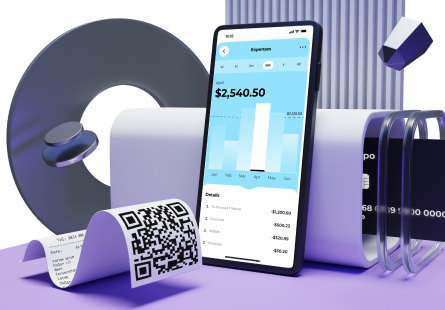It’s safe to say that Web3 technology has triggered a wave of game-changing innovations in fintech. The decentralised version of the Internet is disrupting the traditional financial industry by creating a more open, transparent, and secure digital economy.
What is Web3? How is it different from the previous iterations of the world wide web? And, most importantly, which Web3 technologies and concepts are behind the revolutionary changes in the finance sector? Find the answers in this article.
Web3 explained simply with examples
The internet that we use every day, where we visit websites and use apps, is called Web2. It’s called that because it’s the second version of the internet. Web3 is the third version of the internet, and it’s different from the internet we currently use in some important ways.
One big difference is that Web3 is all about making the internet more decentralised. That means instead of one big company or organisation controlling everything, there are lots of different people and groups who can participate and make decisions together. It’s kind of like how a team works together to play a game, instead of just one person being in charge of everything.
Another difference is that Web3 is designed to be more secure and private. When we use the internet today, we often have to give up some of our personal information in order to use apps or websites. With Web3, we can use the internet without giving away as much of our personal information, which can help us stay safer online.
Here are a few examples of what Web3 might look like in practice:
- Imagine a social media platform where instead of one company controlling everything, users can vote on decisions about how the platform is run. For example, they could vote on what kinds of content are allowed, or how the platform should make money. This would make the platform more decentralised and give users more control over how they use it.
- Another example of Web3 in action might be a digital marketplace where buyers and sellers can trade goods and services directly with each other, without the need for a middleman like Amazon or eBay. This would make the marketplace more decentralised and could help make it more fair for everyone involved.
- Web3 could also be used to create a more secure and private internet. For example, a Web3-based messaging app might use encryption to keep messages between users private, or it might use decentralised storage so that messages are not stored on a central server that could be hacked or spied on.
Overall, Web3 is all about creating a more fair, open, and secure internet that is controlled by many people, rather than just a few big companies. There are many ways that Web3 could be used in practice, and we’re likely to see lots of new Web3-based apps and platforms emerge in the coming years.
Why did Web3 emerge?
Following its earlier predecessors — the read-only Web1 and read-write Web2 — Web3 is the next, read-write-own iteration of the Internet focused on more decentralised and democratic user experiences. Web3 is based on blockchain technology and smart contracts, creating a robust peer-to-peer ecosystem. This means that Internet users can interact directly with each other without the need for third-party intermediaries.
Web3 emerged in response to growing concerns about data privacy, censorship, and the concentration of power in the hands of tech giants and as a result of some significant trends in the world economy:
- many people distrusting centralised financial institutions and searching for alternatives to manage their finances;
- the COVID-19 pandemic promoting working online, which resulted in increased adoption of the metaverse;
- social web creating tools to monetise data and target ads, which led to further mistrust of Web2;
- evolution of cryptography and decentralised computing that is unleashing new technical capabilities;
- independent artists relying on giants such as Youtube or Spotify but having limited control of their audiences and revenues;
- big players like Adidas and Visa embracing NFTs and metaverse land;
- VCs investing billions in metaverse, gaming, and Web3 projects.
What makes Web3 different?
Since its public adoption in the early 90s, the Internet has evolved from the static Web1 to Web2, which introduced social media and user-generated content. Now we’re on the threshold of the Web3 era, where value and data will move across decentralised platforms with distributed ownership and control. Let’s look deeper at the key points that make Web3 different from the previous versions of the world wide web.
- Web3 is decentralised and thus not controlled by governments and corporations. With this disruptive technology, centralised companies no longer own or retain the data, as it gets managed privately.
- While Web2 has revolutionised the Internet by streamlining data generation, collection, and distribution, it also made data privacy questionable. In contrast, Web3 aims to provide a trustworthy, data-driven user interface that caters to every user by employing blockchain technology.
- Unlike Web2, Web3 users remain the owners of their content and have absolute control over using the Internet.
- While digital payments on Web2 are made in fiat money, Web3 welcomes using digital currencies such as Bitcoin or Ethereum.
- Web3 brings cybersecurity to the next level by facilitating data interchange amongst web users.
Technologies and concepts of Web3 shaping the future of the financial sector
Web3 is creating a paradigm shift that is sure to revolutionise the financial services industry. From decentralised finance to blockchain-based smart contracts, the tools and principles of Web3 introduce new forms of economic activity that are more secure, transparent, and accessible than ever before. Below are the key technologies and concepts of Web3 that are driving this transformation and reshaping the future of finance.
Technologies
Wallets
Web3 wallets are the next-gen digital wallets intended to interact with decentralised applications, or dApps, on the blockchain. With a Web3 wallet, users can seamlessly participate in the decentralised finance (DeFi) ecosystem, trade cryptocurrencies, and use non-fungible tokens (NFTs) without ever leaving their wallet. In addition, many Web3 wallets provide users with a private key that allows them to sign transactions on the blockchain, making it easier to access and interact with the decentralised world of finance.
Tokens
A token is a digital asset created, managed, and traded on a blockchain network. Crypto tokens are often used as a medium of exchange or a unit of value within dApps. Unlike traditional currencies, they aren’t backed by any government or centralised authority. Instead, tokens rely on the underlying blockchain network for security and validity.
Tokens can represent anything from cryptocurrencies to real-world assets. They can be programmed with specific rules and conditions, such as smart contracts, to automate transactions and enforce agreements.
Smart contracts
In brief, a smart contract is a program that runs on a blockchain network and determines the behavior of tokens. They help develop sophisticated, decentralised software like asset swaps, NFT projects, etc. At its core, a smart contract is a self-executing contract encoded on a blockchain. It operates automatically, without central authorities or human intervention, making it efficient and secure.
The use of smart contracts is growing across financial markets. Fair enough, since smart contracts allow for transparent, automated processes, making financial transactions such as payments, loans, and insurance faster, more accessible, and more secure.
Blockchain networks
Blockchain networks create the backbone of Web3. They use distributed ledger technology to record transactions and interactions in an immutable, transparent way, providing a new paradigm for trust and a more secure environment for financial operations.
Blockchain networks enable various Web3 applications, including DeFi, gaming, NFTs, social media, etc. They also allow users to interact with these applications using cryptocurrencies.
The fundamental building blocks of blockchain contain individual data segments linked to create secure, tamper-proof blockchain records of all transactions. Whenever new data is added to the network, a new block is built and attached to the chain. Each node within a network is updated to reflect the change, ensuring everyone has access to the latest data.
Blockchain networks remove the need for centralised data storage, meaning there is no single point of failure or control, and the system is immune to censorship.
Concepts
Decentralisation
The fundamental feature of Web3 technology is the decentralisation of business models. While the early 90s web was based on open protocols on which you could build and from which user data wasn’t collected, it eventually transformed into the centralised Web2 in which user data, from identity to credit scores, is captured and often resold. Web3 gives control over the data back to users. With Web3, the control over data is no longer centralised but distributed through permissionless decentralised blockchains and smart contracts.
Ownership
In the Web3 ecosystem, ownership takes on an entirely new meaning, with an unparalleled ability to prove that digital assets belong to their owners. When digital assets are created within a blockchain network, they become part of the network’s distributed ledgers, meaning that only their owners have the power to transfer them. The records of ownership are visible to all participants in the network.
Besides an unprecedentedly high level of security and control over assets, the concept of ownership enables new possibilities for peer-to-peer transactions and decentralised marketplaces, creating a more equitable and transparent financial system.
Programmability
Programmability refers to Web3’s ability to move tokens, data, or value across wallets under certain conditions. Also, “programmable” means any developer can create a new functionality using a token or asset. Unlike Web2, where most interactions are conducted through user interfaces, Web3 enables developers to build complex financial applications with custom rules and logic. The shift toward programmability is revolutionising how financial systems are designed and operated. It allows for greater transparency, automation, and efficiency in lending, borrowing, and investing processes.
Composability
In the world of the decentralised Internet, composability means the ability for different blockchain-based applications and protocols to interact seamlessly with each other. This enables streamlined creation and customisation of a new software product or service, with each component being interchangeable and composable.
Final words
Web3 is set to revolutionise the finance industry. By enabling decentralised financial systems and digital assets, Web3 is reshaping the relationships between consumers and financial service providers. Moreover, Web3 is creating new opportunities for fintech startups to build innovative solutions that offer greater accessibility, transparency, and security to users.







